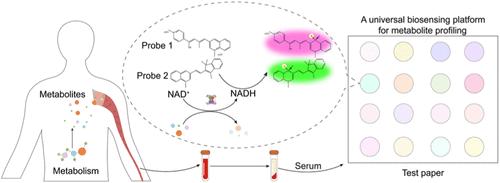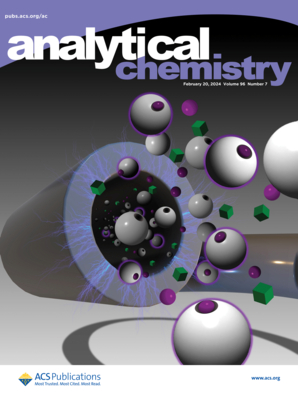Profiling of Biofluid Metabolites with a Kinetically Differentiated Binary Biosensing Platform
IF 6.7
1区 化学
Q1 CHEMISTRY, ANALYTICAL
引用次数: 0
Abstract
Biofluid metabolites have a crucial linkage with the health of the human body, and developing a universal method for metabolite monitoring is imperative for disease diagnosis and health management. Herein, we report a kinetically differentiated binary biosensing platform that is specifically responsive to NAD(P)H for profiling diverse biofluid metabolites. The kinetically differentiated binary biosensing platform comprises a cyanine derivative dye with fast reaction kinetics and a quinolinium derivative dye with slow reaction kinetics. Compared to the traditional unitary strategy for NAD(P)H detection, the linear range of the binary biosensing platform is widened by up to 20 times. NAD(P)H are ubiquitous cofactors in living systems, and metabolite production generally involves the consumption or generation of NAD(P)H. Thus, biofluid metabolites can be easily quantified by measuring the variation of NAD(P)H concentration during biochemical reactions with the binary biosensing platform. In this study, serum sorbitol, 2-hydroxybutyric acid (2HB), and α-ketoglutarate (AKG) were all quantified by the binary biosensing platform with accuracies higher than 93%. The kinetically differentiated binary biosensing platform can be extended to the analysis of any molecule that can react directly or indirectly with NAD(P)H. In addition, we constructed a paper-based assay with the binary biosensing platform, and the test papers showed good promise in the point-of-care (POC) profiling of biofluid metabolites. This study proposes a simple strategy to expand the calibration range of traditional unitary detection systems and further provides a universal paradigm for high throughput profiling of disease-associated biomolecules, which offers good promise in disease diagnosis and health management.

求助全文
约1分钟内获得全文
求助全文
来源期刊

Analytical Chemistry
化学-分析化学
CiteScore
12.10
自引率
12.20%
发文量
1949
审稿时长
1.4 months
期刊介绍:
Analytical Chemistry, a peer-reviewed research journal, focuses on disseminating new and original knowledge across all branches of analytical chemistry. Fundamental articles may explore general principles of chemical measurement science and need not directly address existing or potential analytical methodology. They can be entirely theoretical or report experimental results. Contributions may cover various phases of analytical operations, including sampling, bioanalysis, electrochemistry, mass spectrometry, microscale and nanoscale systems, environmental analysis, separations, spectroscopy, chemical reactions and selectivity, instrumentation, imaging, surface analysis, and data processing. Papers discussing known analytical methods should present a significant, original application of the method, a notable improvement, or results on an important analyte.
 求助内容:
求助内容: 应助结果提醒方式:
应助结果提醒方式:


